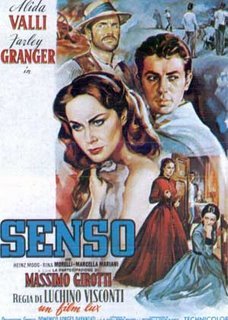SENSO - Shot Analysis
 Senso (1954)
Senso (1954)
Director: Luchino Visconti
Country: Italy
Format: Film Print
I wrote the following shot analysis (1,500 words) for the FILM STYLE AND TEXTUAL ANALYSIS component of my Masters Degree in Film & Television
The particular shot I have chosen to discuss begins with Count Serpieri (Heinz Moog) approaching the balcony of the box from which he has been watching the opera. It ends when Countess Livia (Alida Valli) rests against a pillar in the same box and looks upon the ongoing protests.
The shot is sixteen seconds in duration and is preceded by a low angle shot of the theatre showing four levels of balconies. The lower two floors are filled by white uniformed Austrian soldiers and their well-attired female companions. The higher two floors are densely populated by the more modest dressed Venetian public.
The protest against the Austrian army’s occupation of Venice has already begun with red, white and green paper symbolic of the Italian flag being thrown by the partisan crowd.
The specific shot I shall go on to analyse is succeeded by a seven second shot showing the uproar in the seated area of the theatre, immediately before the stage and orchestra. The camera is positioned in a manner suggestive of Livia’s point of view.
I feel the shot I have selected is significant in terms of the meanings and affect its construction offers. To begin the Count is visibly outraged at the outbreak of such vehement demonstration. The manner in which he looks upon the scenes from his balcony and the tone of his voice as he addresses the Austrian General with whom he has been sharing his box, suggest he is supportive of the Austrian military. Although spoken in German one can assume the Count is apologising for the chaos that has ensued and that he feels the performance should be stopped.
This impression that the Count is associated with the Austrian General is reinforced both through the physical action included in the shot, as well as by costume and props. For example, after the Count’s reaction to the outbreak of political protest, he turns toward the General in order to take him by the arm and escort him from the box.
Both men are affluently dressed, one in pristine white uniform the other in a black suit, perhaps tuxedo after the period fashion. In comparison the majority of the local Venetians are wearing rather shabby attire, mostly navy and grey colours. The Count and the General also share similar facial appearance with gelled or slicked grey hair with moustache and whiskers.
In the brief action that takes place in this specific shot one can also see the Count and the General both carry a rolled up piece of paper in their right hands. It is very probable these are nothing more than performance notes from the opera, however, the fact none of the other people featured in this shot have them raises the articles significance.
The other people included in this shot consist of another Austrian officer, his female guest and Countess Livia. However, upon a first viewing one feels it is the Count and the General whom are the main protagonists. One can make this assertion as the camera is positioned in the left hand corner of the opera box and the Count and the General occupy the front of the shot.
Although static for the most part the camera does in fact move ever so slightly from left to right at the beginning of the shot. This subtle adjustment is geared toward the movement of the Count as he approaches from the left hand side of the box to the right in order to view the spectacle.
Once again the fact the camera maintains the centre of interest upon the Count and General leads one to assume they are the important figures in this shot. The other Austrian solder present serves to reinforce the feeling of outrage at the protests which disturbs the opera.
At the opening of the shot when the Count approaches the balcony the soldier is seen behind at the back of the shot. At this point the General is also at the back of the shot seated next to the soldier, who is gesturing in a disapproving manner. However, once the General rises in response to the words of the Count the soldier exits to the left of the screen following the departure route taken by his female guest. This is important to note in relation to the fact both the Count and the General exit to the right of the shot.
The off screen space consists of the entrance to the box featured in the shot, which is behind the position of the camera and the theatre which can only be glimpsed via the balcony in the shot itself.
The other main point of interest in relation to this specific shot is the movements of Countess Livia. Although at this point in the film one does not know who she is and indeed she doesn’t speak during this actual shot, the fact the only other camera movement is geared toward her changes the viewer’s point of interest.
Livia is also very well dressed in a black ball gown with lilac trim. Her hair is elegantly pulled up and she has sparkling silver brooches both on her gown and in her hair.
With the aid of repeated viewings one can actually see Livia walk across the front of the shot at its very beginning. She does not even make eye contact with her husband whom crosses behind her to approach the balcony. However, any significance that may have escaped the first time viewer to begin with is returned to at the end of this shot.
The Count and the General have exited to the right and the Austrian soldier and his guest have previously exited to the left. At this point the camera ever so slightly returns to the left as Livia enters the shot and approaches the back of the box.
Again Livia and her husband have yet to occupy the shot together and formally interact. Although at this stage in the film the characters are not known to us one cannot help but to sense a distance between Livia and the other people featured in this shot. Later of course one realises Visconti’s use of his actors in this shot, Livia on the left the Count on the right, anticipates the emotional and political divide present between Livia and her husband.
Crowded in a sense with four other people in the shot at its beginning, now only Livia is shown as she walks from the left to the far balcony on the right. Her movements are slow and unhurried in contrast to the other characters hasty exits. Livia rests herself against the pillar with her right hand and turns in that direction to see the scenes unfold.
An important visual element is present in this section of the shot. When Livia enters from the left she is framed by the mirror hanging on the wall opposite. Thematically one could surmise Visconti is symbolising the trapped state Livia is destined to fall into as the film progresses. (word count: 1,207)
Bibliography/Filmography
Senso (1954), Dir. Luchino Visconti.
For more details see:


No comments:
Post a Comment